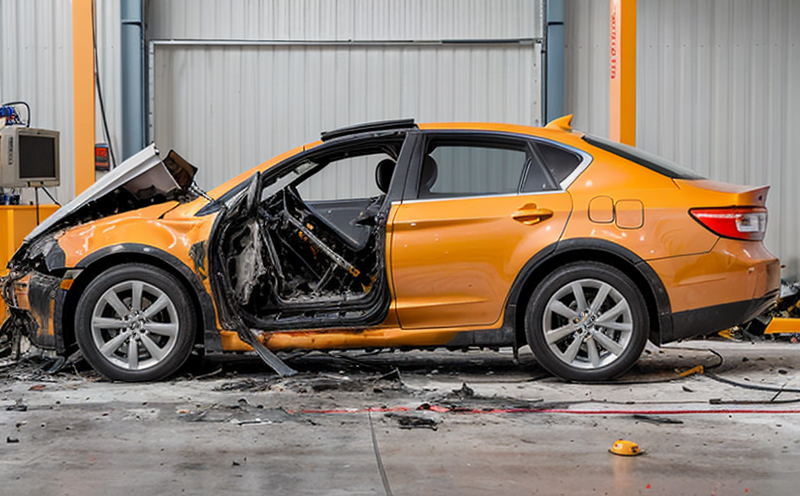BS EN 50342 Mechanical Crash Testing of Automotive Lead-Acid Batteries
The BS EN 50342 standard is a cornerstone in ensuring the safety and reliability of automotive lead-acid batteries. This test evaluates how well these batteries withstand mechanical abuse, particularly during potential crash scenarios. Compliance with this standard is crucial for manufacturers as it helps ensure that their products are robust enough to protect against damage from collisions.
During a typical BS EN 50342 test, the battery undergoes controlled impact conditions to simulate real-world crash environments. The test aims to assess not only the structural integrity of the battery but also its ability to maintain functionality post-impact without leaking or causing electrical hazards. This testing is essential for automotive manufacturers looking to meet regulatory requirements and ensure product safety.
The standard specifies various types of impacts, including drop tests and crush tests, each designed to mimic different potential crash scenarios that a vehicle might encounter. Drop tests measure the battery's resistance to falling from heights typical in vehicle accidents, while crush tests evaluate how well the battery can withstand being compressed by external forces. These tests are conducted under controlled conditions to ensure accurate results.
The mechanical abuse and crash testing process involves meticulous preparation of the test specimens. Before testing, batteries must be preconditioned according to specified guidelines, which may include conditioning at specific temperatures or charging states. This ensures that the battery is in a consistent state for each test run, providing more reliable data.
Accurate instrumentation plays a critical role in this testing process. Sensors and recording devices are used to monitor key parameters such as voltage changes, temperature fluctuations, and current flow during and after impact. These measurements help determine whether the battery has sustained any damage that might affect its performance or safety.
The BS EN 50342 standard also provides clear acceptance criteria for determining pass/fail outcomes of these tests. A battery passes if it remains intact, does not leak, continues to function correctly after impact, and meets all specified electrical parameters. Failure occurs when the battery shows signs of damage that could compromise its safety or performance.
Compliance with BS EN 50342 is particularly important for automotive manufacturers who aim to meet stringent safety standards set by regulatory bodies worldwide. By adhering to this standard, they demonstrate their commitment to producing high-quality products that can withstand real-world challenges without compromising user safety.
This testing protocol has been recognized internationally and forms part of the broader framework used globally in ensuring vehicle safety. The results from these tests contribute significantly towards enhancing overall road safety by reducing risks associated with battery failures during accidents.
Why Choose This Test
- Makes sure batteries meet stringent international standards for mechanical abuse and crashworthiness.
- Provides critical insights into the durability of automotive lead-acid batteries under real-world conditions.
- Ensures compliance with regulatory requirements, thereby protecting the manufacturer's reputation and market access.
- Helps identify potential weaknesses in battery design that could be addressed to improve performance and safety.
International Acceptance and Recognition
The BS EN 50342 standard is widely accepted and recognized by automotive manufacturers, regulatory authorities, and testing laboratories across Europe. Its international acceptance ensures consistent quality standards that are respected globally, facilitating smoother trade and manufacturing processes.
Many countries have adopted this standard as part of their vehicle safety regulations, making it an essential requirement for any manufacturer aiming to sell products in European markets or participate in global automotive supply chains. The widespread adoption underscores the importance of adhering to such standards for achieving compliance with international legal frameworks.
Use Cases and Application Examples
The BS EN 50342 test is particularly applicable during the research and development phases of new battery designs. Engineers use this testing method early on to identify potential issues before full-scale production begins, allowing for timely modifications that improve both safety and performance.
During manufacturing processes, compliance with this standard ensures consistent quality across batches, reducing variability and enhancing reliability. Quality managers can rely on these tests as part of their quality assurance programs, providing data-backed evidence of product integrity.
In the procurement process, specifying adherence to BS EN 50342 helps ensure that suppliers deliver batteries meeting exacting standards. This collaboration between manufacturers and suppliers strengthens supply chain resilience and consistency in performance across different components.





